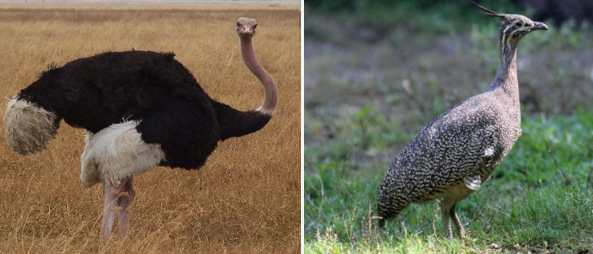©Copyright 2018 GEOSCIENCE RESEARCH INSTITUTE
11060 Campus Street • Loma Linda, California 92350 • 909-558-4548

Sackton, TB, P Grayson, A Cloutier, et al. 2019. Convergent regulatory evolution and loss of flight in paleognathous birds. Science 364:74-78. 5 April 2019. https://doi.org/10.1126/science.aat7244
Summary. Large flightless birds occur only on the southern continents. The African ostrich, South American rheas, Australian emu and cassowary, the New Zealand kiwi and extinct moas, and the Madagascan elephant birds all share certain morphological traits, such as reduction of the wings, a flat sternum without a keel, and a particular arrangement of bones in the palate. It is generally believed that the ancestors of these birds dispersed by flying and later became flightless. The question addressed here is whether the genetic basis of loss of flight is due to mutations in protein-coding genes or in regulatory genes, and whether the genetic changes were similar in the different kinds of birds. Results indicate that similar changes in regulatory genes were involved in the loss of flight in all the flightless birds in this study. Morphological similarity was significantly correlated with similar changes in regulatory genes.

Left: An ostrich in Tanzania; Photo: Nicor, CCbySA3.0; Right: The elegant-crested tinamou, Eudromia elegans, one of the species in this study. Photo: Dick Daniels, CCbySA4.0
Comment. Discovery that similar morphological traits may be due in large part to similar changes in regulatory genes means that morphological similarities can give a misleading impression of similarity due to common ancestry. For living species, this difficulty can be overcome by analyzing genetic evidence, but most fossils do not provide enough genetic evidence to make such comparisons. At least in this case, it seems that genetic regulatory networks provide more information about genealogical relationships than morphology or protein-coding genes do.
The fact that differences in regulatory genes can produce different morphologies from similar structural (protein-coding) genes suggests the metaphor of a “genomic piano.” The same set of “keys” (structural proteins) can produce many different “tunes” (morphologies), depending on the “musical score” (regulatory genes) that determines the sequence and timing in which the “keys” (proteins) are used.
Added note: The large flightless birds are collectively called ratites, and their biogeography and relationships have been debated for many decades. Development of plate tectonics theory stimulated the idea that ratite birds were transported to their present locations by the break-up of Pangaea as the plates where they lived drifted apart. [1] This idea became very popular and was featured prominently in many museums as an example of the effects of plate tectonics. However, the idea fell apart when the tinamous, a group of South American birds, were added to the story. Tinamous are quail-like birds that can fly, but are considered to be related to the larger ratites. In phylogenetic studies, tinamous were more similar to rheas [2] or to moas [3] than to ostriches. Since tinamous can fly, this means the giant birds did not all inherit flightlessness from a common ancestor, but different groups lost flight independently. In addition, no fossil ratites are known from sediments deposited before Pangaea broke apart, so ratite history had to be re-written. Rather than a story of millions of years of drifting apart on tectonic plates, ratite biogeography appears to be a story of several different ancestral groups that dispersed by flying to isolated regions. In these environments, natural selection was weak, and they lost the ability to fly due to degeneration and grew to large size. This interpretation is more consistent with creationary theory.
ENDNOTES
[1] Cracraft, J. 1974. Phylogeny and evolution of the ratite birds. Ibis 116:494-521.
[2] Harsham, J, EL Braun, MJ Braun, et al. 2008. Phylogenomic evidence for multiple losses of flight in ratite birds. Proceedings National Academy of Sciences 105(36):13462-13467.
[3] Sackton, et al., in this report.